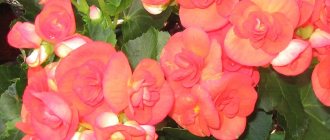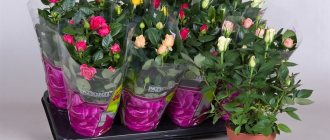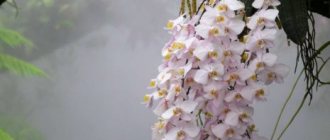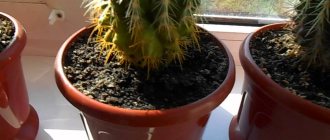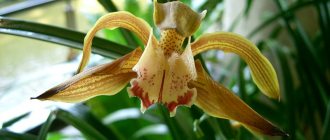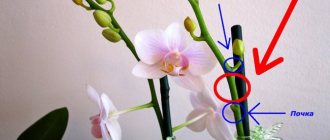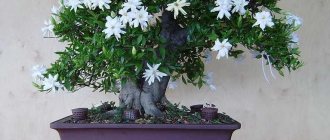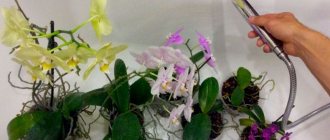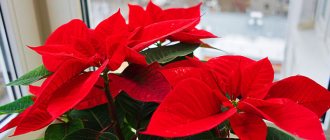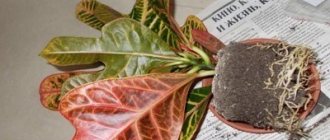The diversity of begonias is amazing: botanists count about 1,600 species, and the number of currently existing cultivated varieties and hybrids is beyond counting (1). The main habitat of begonias in the wild is the tropical rainforests of South America and Africa, as well as the mountainous regions of Asia.
The first representatives of the species were described by the French monk-researcher Charles Plumier during an expedition to the islands of the Antilles archipelago. The organizer of the expedition was the quartermaster of the French fleet in Marseille, Michel Begon, in whose honor Plumier named the new genus of plants he discovered.
Begonia has been cultivated since the 19th century, and the appearance of the first hybrid varieties dates back to the same time. There are not only indoor, but also garden varieties of begonias that are grown in open ground (2).
Types of indoor begonia
As mentioned above, the number of species, varieties and hybrids of begonia is very large, so their classification causes difficulties even for specialists (2). According to the nature of the growth of the above-ground part, begonia species can be divided into herbaceous, subshrubs and liana-like (ampeloid). According to the characteristics of the development of the root system - rhizomatous and tuberous. According to decorative properties - flowering and decorative foliage (3). It is clear that it is not possible to list all types of indoor begonias here, so it makes sense to mention only the most common ones.
Decorative foliage
Royal begonia (Begonia rex). A species with leaves that are irregularly heart-shaped or curled at the base in the form of a “snail,” glabrous or slightly pubescent. With a typical plant height of 40 - 50 cm, the leaf plate can be up to 30 cm long and up to 20 cm wide, but more compact varieties of this begonia are popular among gardeners. The palette of colors of royal begonia leaves is huge: there are all kinds of transitions of green, red, crimson, brown and even silver tones; there are varieties of begonia with almost black, speckled, edged leaves. The flowering of this begonia is inconspicuous.
Popular varieties:
- Merry Christmas - with soft transitions of cherry, pink, emerald and silver tones;
- Evening Glow - the middle of the leaves is bright crimson, towards the edge the shade turns into silver with a dark reddish border;
- Escargot is an unusual variety with a very pronounced “snail” shape of the leaf, spirally twisted towards the petiole, the shade of the leaves changes from dark green in the center through a wide silver stripe to green-olive at the edge;
- Hallelujah (Hallelujah) – leaves have a pointed shape with a moderately pronounced “snail-like” appearance, the core and border of the leaf are red-violet, between them there is a green leaf with silver inclusions;
- Inca Night is a very bright variety with pointed leaves of a rich red color with a very dark brown border.
Begonia regal Merry Christmas. Photo: pixabay.com
Begonia royal Hallelujah. Photo: pixabay.com
Bauer's begonia, or tiger begonia (Begonia bowerae). Compact begonia (up to 25 cm) with medium-sized rounded leaves of spotted color, which have pubescence on the back side and sparse “hairs” along the edges. The shoots are creeping, so the plant can be grown in hanging pots. The flowers are unremarkable.
Varieties:
- Cleopatra - with pointed “star-shaped” leaves of a dark green color with noticeable pubescence on the outside, which gives the leaf a silvery tint;
- Tiger - leaves are round, with dark brownish veins and light green spaces, the plant is compact, shoots rarely reach a length of more than 15 cm.
Metal begonia (Begonia metallica). The heart-shaped or pointed leaves of this begonia have a rich green color with a “metallic” tint. A very compact type of begonia with shoots about 10 cm long.
Red leaf begonia, or Fista (Begonia erythrophilla). “Grandma’s” begonia has a very recognizable appearance with round, smooth or slightly folded glossy leaves on dense petioles. The reverse side of the leaves is shiny, dark pink or red. Plant height is up to 25 cm, width is often greater than height.
Begonia Bauer variety Tiger. Photo: commons.wikimedia.org
Blooming
Coral begonia (Begonia corallina). A large shrub-type begonia, reaching a height of 90 - 100 cm. The leaves are oval-pointed, green, with small light specks. This type of begonia blooms beautifully with small pink or red flowers in strongly drooping clusters of inflorescences. There are few varieties; there are varieties of this begonia with serrated leaves, for example, President Carnot.
Begonia coral. Photo: pixabay.com
Ever-blooming begonia (Begonia semperflorens). A shrub up to 60 cm high with abundant and very long flowering; in indoor conditions it can last almost the whole year. The leaves are medium-sized, rounded, the flowers are double, in different shades of pink and red, sometimes white. There are a lot of varieties and hybrids of this begonia, some are compact with larger flowers. It is quite difficult to single out the most popular varieties of this begonia due to their large assortment; new hybrids appear literally every year.
Begonia ever-blooming. Photo: pixabay.com
Begonia elatior, or winter (Begonia x elatior). These plants are sometimes mistakenly classified as a separate species, but in fact Elatior is a group of hybrid begonias of not entirely clear species. This variety of flowering begonias is one of the most popular among flower growers and breeders; its distinctive feature is the ability to bloom in winter. The height of an adult plant is about 30 cm (sometimes up to 40 cm), it forms a dense bush with a “bouquet” appearance. The flowers are small, but very numerous, depending on the variety they vary from simple to densely double. The shades of the flowers are bright and varied, there are only begonias with flowers in cold blue tones. You can find varieties of Elatior begonias with bicolor or edged flowers.
Begonia elatior. Photo: pixabay.com
Photo: pixabay.com
Photo: pixabay.com
or hanging begonia (Begonia pendula). Strictly speaking, this is not a species, but a collective name for a group of begonias with hanging shoots that are grown in pots and hanging baskets. Most often these are begonias with a tuberous root system. Ampelous begonias vary widely in the shape and shade of leaves and flowers; the flowers are most often white, red, pink and yellow, drooping, located at the ends of the shoots. An interesting variety is the Cascade series, which includes plants with double flowers.
Brief description of the plant
Begonia can be different; there are varieties of herbaceous plants that do not exceed three centimeters, as well as shrubs with rather high branches.
Some begonia species have no stem or only one leaf. The foliage of the plant is green, the reverse side is covered with a single color or with spots and patterns.
It blooms with bright flowers in different warm shades. The flowers resemble rose petals or carnations in appearance. Flowering occurs at the beginning of summer and continues until autumn. Indoor begonia blooms longer than plants growing outside. The home flowerpot blooms from May to late autumn.
Caring for indoor begonia at home
The difficulty of caring for begonias can vary depending on the species. The easiest to grow are royal begonias, Bauer begonias, red-leaved begonias, everflowering begonias and elatior begonias.
Priming
The soil for begonias should be nutritious, loose, slightly acidic and with good water and air permeability. Experienced gardeners believe that soil requirements differ for flowering, decorative-leaf and tuberous begonias.
When purchasing ready-made soil for decorative deciduous species, it is better to choose a specialized one designed specifically for begonias. You can also plant flowering ones in it, but it is better to look for a special composition for flowering begonias or for other flowering plants with similar requirements for soil characteristics. For tuberous begonia, nutritious soils for flowering indoor plants are suitable, where you can add perlite or vermiculite.
When purchasing, pay attention to the composition of the soil mixture: it is desirable that it contains vermicompost, vermiculite, micro- and macroelements.
Lighting
Begonia prefers bright, diffused light without direct sunlight, which can burn the delicate leaves. For flowering begonias and decorative deciduous varieties with brightly colored leaves, bright light is a must. Metallic, red leaf and coral begonias tolerate some shade. An interesting feature of Elatior begonias is that they bloom only after daylight hours are reduced to 9 hours - which is why they usually bloom in the cold season. In order for the flowering to last for a long time, after the formation of buds it is very important not to move the plant - changing the lighting (up to the angle of incidence of the light rays) leads to a deterioration in flowering.
Humidity
Begonias need moderately humid air. In the warm season (if there is no heat for many days), the level of humidity in a ventilated room is quite sufficient for it. In winter, indoor air is usually dry due to heating devices, so begonias require additional moisture. The best option is a room humidifier. If it is not there, the pot with begonia can be placed in a tray with damp expanded clay, pebbles, moss, sand or other similar material. As a last resort, a wide, low container of water will do, which should be placed near the begonia pot.
Be careful: it is strictly not recommended to spray begonias, as this leads to the appearance of spots on the leaves.
Watering
Correctly adjusting watering is the main difficulty in caring for begonias. They are moisture-loving, but overwatering very quickly leads to rotting of the roots. Overdrying is also dangerous for them, so maintaining optimal soil moisture is very important.
In summer, begonias are watered generously about 2 times a week; in extreme heat, the frequency, but not the volume, of watering is increased. In between waterings, the soil in the pot should dry out, but not dry out completely (you can check this by plunging your finger into the soil: at a shallow depth it should already be wet).
In winter, the frequency and volume of watering for most begonias is approximately halved. For Elatior begonias, during the flowering period, maintain the usual level of soil moisture, and after flowering, watering is reduced so that the soil dries out almost completely, but does not dry out completely. Tuberous begonias with a pronounced dormant period in winter are not watered at all or almost nothing. When watering tuberous begonias, you need to make sure that water does not fall directly on the tuber.
Water for watering begonias must be warm and well-settled. If the tap water in your area contains a lot of lime, this can lead to alkalization of the soil in pots with begonias, so it is recommended to sometimes add a few drops of citric acid to the watering water.
The best time to water begonias is morning. In the warm season, they can be watered in the evening, but not during the day, in the heat.
Begonias benefit from periodic loosening of the soil after watering - this improves air access to the roots. Any water that gets into the tray is drained immediately.
Fertilizers
It is best to use special liquid fertilizers for begonias - they have a balanced composition suitable specifically for this crop. You can also use fertilizers intended for decorative deciduous and flowering indoor plants.
Fertilizers with a large amount of nitrogen are suitable only for begonias with decorative leaves, as they contribute to the formation of green mass. Flowering begonias need compounds with a predominant content of phosphorus and potassium. For flowering begonias, especially Elatior, you can use a long-lasting fertilizer such as tablets or sticks.
Feeding
Begonias are fed during the period of active growth, from April to the end of September, once every 2 weeks, applying liquid fertilizers along with watering. Elatior begonias can be fed somewhat less frequently - once every 3 weeks. Begonias that bloom in winter are fed at this time once a month; after flowering, feeding is stopped.
Since there are many types of begonias, general recommendations may not suit your specific flower, so it is better to start fertilizing with a dosage of 1/2 of the recommended one. With an excess of nitrogen, flowering begonias develop abundant foliage, but the buds do not set.
Shredding, paleness and falling off of healthy leaves, stunting of growth during the active growing season, and dying off of buds may indicate a nutrient deficiency. Monitor your plants and adjust the dose and feeding schedule based on their condition.
Trimming
In bush begonias, it is recommended to pinch the tops of the shoots - this allows you to form a lush bush.
Flowering begonias need to cut off flower stalks after flowering. Elatior begonias go into a dormant period after flowering, and many gardeners practice rather radical pruning of all shoots, which renew themselves after the plant enters the growing season.
Old shoots of many types of begonia tend to become bare, losing leaves, so it is recommended to remove them.
For sanitary purposes, dry and damaged leaves and shoots are removed from all types of begonias.
What kind of soil is needed?
The substrate for transplantation should be light, moderately nutritious, permeable, with a stable structure.
For begonias, the planting mixture is prepared on a peat basis. However, soil composition is different for different groups:
- To transplant cotoneasters, shrubs, and hanging species (not flowering ones), you can take a ready-made substrate for decorative foliage plants. The same requirements apply to easy-growing rhizomes.
- The soil for Kazan begonia should be very light. Store-bought mixtures for cacti and succulents are suitable.
- The soil for tuberous begonias and beautifully flowering begonias with branching roots is prepared independently. Use leaf humus, peat, turf soil, perlite (2:2:1:0.5). Or buy a mixture of Saintpaulia and Begonia.
- Planting the most capricious rhizomatous species: Rex (Royal), Mason, Imperial begonias from ready-made substrates is possible only in professional ones. However, it is problematic to find it in packages smaller than 100 liters. A homemade substrate is prepared from acidic peat, decomposed humus, leaf and turf soil (2: 2: 2: 1).
- Other rhizomatous species can be planted in the same mixture or in ready-made decorative soil with the addition of up to 20% perlite.
If you prepare the substrate yourself, disinfect its elements.
Reproduction of indoor begonia at home
The begonia flower is easily propagated vegetatively - by cuttings, dividing bushes and tubers, and rooting leaves. You can grow begonias from seeds, but the seeds you collect yourself are most often not suitable for this: the most beautiful begonias are usually of hybrid origin, and in hybrids, daughter plants grown from seeds do not inherit parental characteristics.
By cuttings. The simplest and most convenient method, especially since you can use waste from begonia pruning done in spring and early summer.
Cuttings can be obtained from any part of the shoot, the main thing is that they have at least 2 - 3 nodes. Leaves, except the top ones, are removed, the cutting is placed in a glass of water at room temperature and kept in a moderately warm and well-lit place. After the roots appear, the begonia is transplanted into the ground.
You can root cuttings directly in the soil. To do this, the lower part of the cutting is dusted with a root formation stimulator (for example, Kornevin), then the cutting is placed in a moist substrate. The container is covered with a bag or transparent plastic and kept in a warm, bright place, periodically ventilating and, if necessary, moistening the soil. A sign that the cuttings have taken root is the appearance of young leaves. After this, the lid is removed and the plant is cared for as usual.
By division. Practiced for bush and tuberous begonias, it can be combined with spring replanting. Division is useful primarily for overgrown and aging begonia flowers, which are thus rejuvenated.
The plant is carefully removed from the pot, the roots are cleared of soil or, if necessary, lightly washed. The rhizome is cut with a sharp sterilized instrument so that each part has approximately an equal number of strong shoots. The cut is sprinkled with activated carbon or wood ash. Delenki are planted in pots.
The technology for dividing a tuber is almost the same: the tuber is cut so that each part has healthy sprouts, the cut is allowed to dry and sprinkled with coal or ash. After this, the divisions are planted in the ground and kept in a warm, bright place, protected from direct sun.
Leaf. The method is well suited for begonias with short or weak stems.
The propagation leaf is cut off with part of the petiole and placed in a glass of water, which is changed every day. After the roots appear, the leaf is planted in the ground - it will give rise to a whole plant.
Parts of a leaf. A somewhat more labor-intensive method and not always successful, but it allows you to get several plants from one leaf at once.
The leaf is cut and the veins are cut on the reverse side or divided into segments so that on each of them there remains one longitudinal and 2 or more transverse veins. The lower part with the longitudinal vein is buried in wet sand, the container is covered with a transparent lid and kept in a warm, bright place, periodically ventilated. If necessary, moisten the soil with a spray bottle.
Rooting may take up to 3 months. Young plants obtained in this way grow very slowly at first.
Landing
Fill the prepared flowerpot one third with expanded clay; to prevent fungal diseases, add a small layer of charcoal. Pour some of the prepared soil on top. After placing the begonia in the prepared pot, carefully add the missing soil and water the plant generously.
It is best to plant begonias in the spring - March - April. At this time, the day is already long enough and the level of lighting is sufficient for the harmonious development of the plant.
If you are preparing tuberous begonias for planting, you must first germinate them in a bright, damp place at a temperature of 16-18ºC.
Transplanting indoor begonia at home
Begonias are usually replanted in early spring; adult plants with active growth require replanting once a year. Plants planted in large pots or slowly growing ones can be replanted once every 2 years. Elatior begonias are replanted after flowering has ended, when the plant enters a dormant period.
The signal about the need for replanting is the roots coming out of the drainage holes of the pot. It is recommended to divide heavily overgrown and old bushes during transplantation.
A new pot for a begonia flower should be 2 - 3 cm larger than the previous one. The roots of most begonias are sensitive, so it is advisable to transfer the plants into a new container, retaining a significant part of the earthen clod - just carefully shake off the excess soil.
It makes sense to wash the roots if root rot is suspected. The washed root system is inspected, all damaged and rotten roots are removed, then soaked for about an hour in a pink solution of potassium permanganate. Before planting in a new container, the roots are slightly dried.
When planting, do not bury the root collar of begonias or compact the soil too much. After transplantation, the plant is returned to its usual place, provided with abundant regular watering and protection from direct sun.
Temperature
Begonia is very picky about room temperature. It does not tolerate extreme heat well.
The temperature range that is comfortable for her is from 20 to 24°C. In winter, this heat-loving plant needs to maintain a temperature of at least 15°C.
An increase in air temperature to 30°C and above leads to a severe slowdown in growth and lack of flowering. A decrease in temperature below 15°C also affects begonia. Temperatures below 5°C lead to damage to the plant leaves and their death.
Tuberous begonia species require cold wintering. Their tubers are dug up and stored in a dark room at a temperature of 5-7°C. After the end of the dormant period in the spring, they are germinated. In this case, it is necessary to maintain a temperature of about 18°C.
In summer, begonias are grown on open balconies and loggias. With the onset of warm weather, they are taken out into the open air during the day and taken into the room at night. They are finally taken out to the loggia when the night temperature is no lower than 15°C.
Diseases of indoor begonia
Root rot . This disease of indoor begonias is caused by pathogenic fungi and in the vast majority of cases is the result of excessive watering. Signs of the disease are begonia stopping growth and dying leaves throughout the plant. You can accurately determine that a begonia has developed root rot only by removing it from the pot.
Affected roots are blackened, limp, and easily separated from the plant. If only part of the root system is affected, all diseased roots are removed, the root system is soaked in a fungicide solution: Vitaros, Oksihom, Alirin-B, Ordan (4), etc. Then the plant is transplanted into fresh soil.
If the begonia is severely damaged, it is unlikely that it will be possible to save it; you can try to root cuttings from it.
Gray rot . It primarily affects the above-ground part of the plant, and is especially dangerous when the begonia flower is kept in conditions of high temperature and humidity. Signs of gray rot are “watery” grayish spots on the leaves and petioles. Over time, the spots increase in size, become slimy, and parts of the plants die.
If gray rot is detected, all affected parts of the plant are immediately removed, the begonia is treated with copper-based fungicides: Khom, Oxychom, Bordeaux mixture 1% (4).
Powdery mildew. This begonia disease develops in high humidity and is most often introduced from other plants. A sign of the disease is a very characteristic powdery coating on the leaves and/or other parts of the plant.
To combat powdery mildew, use the copper-containing fungicides mentioned above or a solution of colloidal sulfur in a concentration of 0.3 - 0.5%.
Vascular bacteriosis . The disease manifests itself as yellowing and darkening of the leaves, starting from the edges. A very characteristic sign is the darkening and death of leaf veins.
In the early stages of the disease, the plant can be saved by removing the affected parts and treating the plant with fungicides. In case of severe damage, it is better to get rid of the diseased begonia.
Ring spot . A very dangerous disease of indoor begonia. Signs are yellow and brown round spots, often with areas of necrosis in the middle. The leaves may take on a reddish tint.
The disease is viral in nature, so there is no cure for it. You need to get rid of a diseased plant as soon as possible to avoid infecting the rest.
Humidity
Tropical begonias in their homeland grow in high humidity, so they need to create similar conditions in the apartment.
Regular watering and spraying of begonias will help maintain the required air humidity..
Often a pot of begonia is placed in a wide tray with expanded clay or coarse sand, which should always be slightly damp, but not wet. This helps humidify the air around the plant.
In hot weather, begonia needs to be sprayed, but this must be done very carefully. Only plants with smooth leaves can tolerate water getting on the leaves; species with pubescent leaf blades cannot be sprayed, but only spray water near the plant to humidify the air.
Pests of indoor begonia
Aphid. These are very small, wingless, greenish insects that can be detected with the naked eye. Signs of pest damage to begonias are paleness and dying of leaves.
The most convenient way to combat aphids is with the help of a special green soap; in extreme cases, you can use laundry soap. Sometimes tobacco infusion is used at home. Among agrochemical agents against aphids, Actellik or Fitoverm are used (4).
Whitefly . A winged insect of a whitish color with a body length of up to 2 mm. Signs of infestation are the same as for aphids.
The means of control are similar: washing the plant with green soap (2 - 3 times at intervals of several days) or insecticidal preparations: Actellik, Fitoverm (4).
Spider mite. The most common pest of begonias and other indoor plants, manifesting itself as weakening leaves and a characteristic cobwebby coating on different parts of the plant.
For spider mites, the same remedies are used as for aphids and whiteflies; Kleschevit has proven itself well (4).
False shield . Large pests of begonias, up to 4 mm in size, are easily identified as brown “shield” growths attached to the leaves, most often on the reverse side.
Begonias with dense, few leaves can be removed from scale insects mechanically: the plant is washed with green soap, removing scale insects with a soft toothbrush. If the lesion is severe or begonia with delicate foliage is infected, the plant must be treated with Actellik or Aktara (4) according to the instructions.
Thrips . A dangerous pest of indoor begonias and other plants is a winged insect up to 2 mm long. Adults are black or dark brown, larvae are orange.
For thrips, use the same remedies as for false scale insects, and be sure to treat the soil in the pot. In case of severe thrips infestation, it makes sense to transplant the begonia into fresh soil.
Lighting
Decorative begonias love sunlight and will delight you with their picturesque colors when you place them on a south-facing window.
It is advisable to grow flowering begonias at home on windows in eastern and western directions.
Begonias love freedom and even illumination; when placing them next to other plants, leave space between them. Make sure that neighbors do not shade the flower, otherwise it will suffer.
In autumn-winter, compensate for the lack of lighting with special lamps.
Popular questions and answers
We discussed the problems of growing begonias with agronomist-breeder Svetlana Mikhailova.
How to choose indoor begonia?
It is better to buy begonia in specialized indoor plant stores or garden centers. When buying begonias in the supermarket, make sure that the soil in the pot is not waterlogged and that there are no signs of rot or traces of pests on the petioles and leaves. It is better to decide on the type and variety of begonia before purchasing and compare the requirements of the plant with your ability to provide care for it.
How to care for indoor begonia after purchase?
Immediately choose a permanent place for the begonia where it will grow. A change of environment is stressful for a plant, so at first you should not disturb it, much less replant it. Provide begonias with moderately warm conditions without drafts and proper regular watering.
What kind of pot is needed for indoor begonia?
Most types of begonias require a compact, low pot made from natural materials. When replanting, the diameter of the new pot should be 2 - 3 cm larger than the diameter of the earthen ball; a drainage layer must be laid at the bottom of the pot.
Does indoor begonia bloom?
Decorative flowering species and varieties are grown precisely for the sake of beautiful flowering. Decorative deciduous trees also bloom, but their flowers are small and inconspicuous, although some gardeners find a certain charm in them.
Why do the leaves of indoor begonia dry out?
If we are not talking about pests and diseases, then the reason is insufficient watering, too dry air or hypothermia of the plant. Often the cause of leaf death is sunburn, especially in the summer, in the heat.
Nutritional deficiency can also play a role if begonia is not fed or fed too rarely. You can also suspect a nutritional deficiency by shredding the leaves.
Why do the leaves of indoor begonia turn yellow?
Most often for the reasons listed above. Sometimes yellowing of the leaves is caused by the begonia being watered with too cold or hard water containing a large amount of lime.
Why does begonia stretch?
Too long, thin shoots and pale, sparsely spaced leaves are a sign of an acute lack of light, improper pruning or aging of the plant. Begonia should be kept in bright, indirect light and the tips of the shoots should be pinched. “Overgrown” shoots tend to become bare and produce small leaves, so the appearance of such shoots is a signal that it’s time to divide and plant the begonia.
Sources
- Catalog of the plant collection of the Central Botanical Garden of the SB RAS https://www.csbg.nsc.ru/catalog/kollektsiya-tropicheskih-i-subtropicheskih-rastenij.html
- Tamberg T. G., Ovchinnikov Yu. A. Begonia. // L.: Lenizdat, 1989
- Hessayon D.G. All about indoor plants // M.: Kladez-Buks, 2005
- State catalog of pesticides and agrochemicals approved for use on the territory of the Russian Federation as of July 6, 2022 // Ministry of Agriculture of the Russian Federation
- https://mcx.gov.ru/ministry/departments/departament-rastenievodstva-mekhanizatsii-khimizatsii-i-zashchity-rasteniy/industry-information/info-gosudarstvennaya-usluga-po-gosudarstvennoy-registratsii-pestitsidov-i-agrokhimikatov/
Top dressing
The domestic Begonia plant loves fertilizers and will thank you with abundant and bright flowering. It is recommended from mid-spring to mid-autumn to water the plants once every two weeks with a mineral-vitamin complex for flowering plants.
In specialized stores you can choose a suitable complex for your plants. For flowering species, choose phosphorus-potassium fertilizers; for decorative deciduous species, fertilizers with a high nitrogen content are suitable.
From November to March, flower fertilization should be stopped and begonias should not be prevented from resting before the next blooming year.
Peculiarities
Do not move begonia from place to place
In order for this demanding plant to bloom and grow well, you need to know some features of caring for it.
Begonia loves stable conditions and does not tolerate changes. Even moving it to another room is not recommended to avoid illness or even death.
Drafts can be detrimental to begonias . Therefore, the pot with this flower should be placed where air movement is minimal, and the plant should be covered when ventilating the room.
Decorative deciduous species can grow throughout the year, but flowering varieties require a dormant period. At this time, watering is reduced, and tuberous varieties are not watered at all.
Watering methods
There are several proven methods of watering that have a beneficial effect on the general condition of this house plant. For example, many home flower lovers use the so-called immersion method. To do this, you need to take a wide and deep container, for example, a large basin. It should be filled with water, and then a pot with a plant should be placed in it. The water level should not reach the edges of the pot. We leave it there for literally 20-25 minutes. This method allows the plant to absorb moisture on its own and absorb as much liquid as necessary.
If you have a lot of house plants in your house and it is difficult to keep track of them all and ensure timely watering, then you can switch the flower to wick watering. In addition, this method of watering will help you out if you need to leave home for several days. This method of watering is well suited for tuberous begonias.
Don't forget that indoor plants are living beings and not just decorative elements. Take care of them, and they will always delight you with flowering and healthy appearance.
You will learn how to properly water begonia from the video below.
Source
How to choose a flower in a store, what to look for
To avoid having to treat all house plants, begonia in the store should be inspected for pests and diseases. What to pay attention to:
- Are there dark or dried spots, which indicates a fungal disease?
- Damage to sheet plates due to careless handling. Such leaves will still dry out and fall off.
- Are there any crawling insects or thin webs, which indicates a spider mite infestation?
After purchase, the plant is immediately transplanted into nutrient soil, since before that it was in transport soil. It is recommended to remove the flower away from others for a couple of weeks. If an infection goes undetected, you won’t have to treat everything.
Video: Begonia - secrets of care
Trimming / Support / Garter
The appearance of begonias needs to be looked after by cutting off fading old leaves.
Before pruning your begonia, you need to carefully examine the plant for disease and pest damage.
On flowering specimens, it is recommended to remove the female flowers, which prolongs the flowering period.
And in tuberous begonias, with the onset of autumn , new buds need to be removed so that the plant can form tubers and prepare for the dormant period.
A garter is necessary only for tall varieties so that their shoots do not break under their own weight. To do this, install supports and tie the plant to them.
To form a decorative begonia bush, it must be pruned. This is done in the spring before intensive plant growth begins.
Only certain types of begonia are pruned. Decorative deciduous species are usually not pruned at all, since they have very short and thick shoots. Tuberous varieties also do not need pruning. Begonia Elatior is lightly pruned, removing only the tops of its powerful and fairly short shoots. Only ever-flowering begonia is subjected to significant pruning.
Ever-blooming begonia has fairly long and thin shoots. It is pruned to stimulate branching and form a lush bush. At the same time, all elongated and weak shoots are removed. Powerful and fairly long branches are shortened by half.
When pruning, use only a sharp garden knife . Scissors should not be used, as they severely damage the shoots, which then quickly rot. All sections are treated with crushed activated carbon.
Problems
Sometimes, due to improper care, a plant loses its decorative appearance, which signals the beginning of problems. In this case, errors must be eliminated as soon as possible, because begonia is very capricious and often dies even with the slightest errors in care.
If brown spots have formed on the leaves of the plant and the flowers have darkened, this indicates water ingress. It is necessary to reduce the humidity in the room, and in the future more carefully water and spray the plant.
Lack of moisture causes leaves and buds to fall off . And if the leaves curl and dry out, this is a sign of a pest attack.
When a plant is exposed to sunlight, burns in the form of light, dry spots are inevitable. With a lack of lighting, the color of the leaves turns pale and the plant does not bloom.
